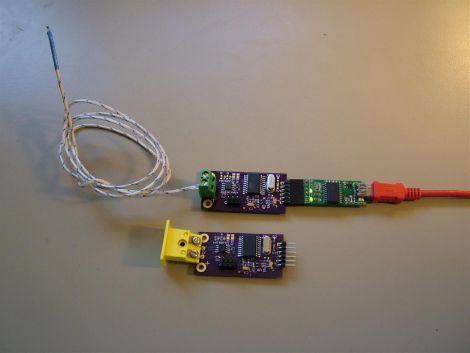

Since we are in the midst of featuring a wide assortment of ATtiny hacks, [Kenneth] wrote in to share a project he has been developing over the last few months, the SerialCouple.
Most all development platforms have the ability to function as an analog to digital converter, but you don’t always need a full-featured board when all you require is serial output for your computer. With his SerialCouple board, [Kenneth] is trying to take some complexity out of the process by building a standalone thermocouple ADC board. The SerialCouple is designed to take analog readings from a thermocouple, converting them to digital values that can be sent to any device over a serial connection. The grunt work is done by a Maxim MAX31855 chip, which converts the thermocouple’s analog data to digital temperature readings. The digital representation of the temperature is then retrieved by the on-board ATtiny2313, which sends the data out the serial port.
If a standalone thermocouple ADC board is something you’ve been looking for, be sure to swing by his site to take a look at his code and schematics.
Continue reading to see a short video demo that explains how the SerialCouple works.
[youtube=http://www.youtube.com/watch?v=_y5MDVV93To&w=470]















so instead of cheip opamp and + atmega8 he chose to use $10 Maxim MAX31855? (yes, its $10 or more with shipping)
MAX31855’s are only $4 a piece in quantity, which is quite a bit cheaper than a cold-junction compensator and chopper op-amp, at a lower part count and simpler analog routing. Also, having a single PCB with drop-in replacement for targeting any standard junction is an advantage compared to using something like an LT1025.
The amazing thing is that he was able to get MAX31855s. Getting small quantities out of Maxim is near-impossible.
It does seem like the MAX31855 is overkill in general…it has 14 bit resolution when even the best thermocouples are only about 10 bit…but that won’t hurt anything so long as you are not assuming that it will actually have 14 bit accuracy.
Who made the boards? They look nice.
I certainly wouldn’t say 14 bits is excessive. Precision and resolution are usually more important than accuracy. You’ll rarely use more than the bottom 10 bits, but the data frame has to be large enough to accommodate every junction temperature range, while still giving a decent resolution (which is 0.25 degrees).
The boards were made by James Neal.
“even the best thermocouples are only about 10 bit” Dude, they are alalogue components…
I know, right? I read that and was like o_O
To all the people saying 14 bits is excessive: It’s important to note that, while 14 bit precision may be overkill without good calibration from an accuracy standpoint, it will read very small temperature differences just fine, which for some applications is more important than just having an accurate temperature reading.
Yes, and analog components have a wonderful property that digital ones don’t, and this property does translate roughly to bit precision: NOISE.